Amano R.S., Sunden B. (Eds.) Computational Fluid Dynamics and Heat Transfer: Emerging Topics
Подождите немного. Документ загружается.

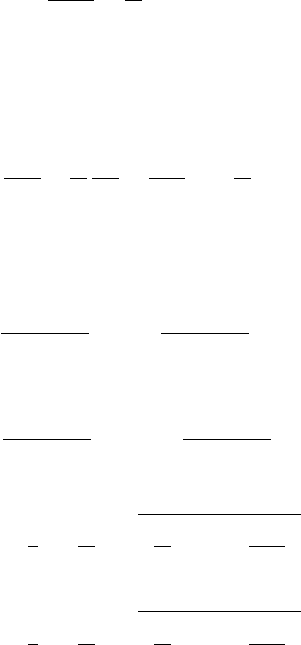
Sunden CH011.tex 10/9/2010 15: 22 Page 436
436 Computational Fluid Dynamics and Heat Transfer
surface, the standard DF approximation is expected to significantly overestimate
particle inertia at the wall and may be mesh dependent.
To improve performance of the standard DF approach, velocity cor rections
are proposed for particle conditions at the initial point of particle-to-wall contact.
Instead of utilizing velocity at the near-wall cell center as with the standard DF
model, theparticlevelocity atthewallis determined basedon asubgridsolution of
particlemotionbetweenthecontrolvolumecenterandwalllocation.Themotivation
behind this subgrid solution is that fully resolving near-wall finite particle inertia
with a continuous model would require an excessive number of control volumes.
Instead,theDF-VCmodelemploysananalyticsolutionofparticlevelocitybetween
thenear-wallcontrolvolumecenterlocationandthewall(Figure11.3).Itisassumed
that the continuous field model approximates particle diffusion within this region.
Furthermore, for low particle Reynolds numbers the individual Lagrangian trans-
porttermsbecomelinearandseparable.Particleinertiabetweenthecontrolvolume
centerandwallsurfacecanthenbe approximatedonadiscreteLagrangianbasisas:
dv
p, n
dt
=
1
τ
p
(u
p, n
− v
p, n
) (14)
To formulate an analytic solution of equation (14), the wall-normal fluid velocity
is assumed to vary linearly betweenthe control volume center and zeroatthe wall.
The resulting equation for particle position between the near-wall control volume
center and the wall as a function of time can be written as
d
2
x
p
dt
2
+
1
τ
p
dx
p
dt
+
u
cv,n
sτ
p
x
p
=
1
τ
p
u
cv, n
(15)
where u
cv,n
is the fluid velocity at the control volume center location normal to
the wall.An analytic solution to equation (15) is possible resulting in wall-normal
expressions for particle position
x
p
(t) =
v
cv,n
+ λ
2
s
λ
1
− λ
2
e
λ
1
t
−
v
cv,n
+ λ
2
s
λ
1
− λ
2
+ s
e
λ
2
t
+ s (16a)
and velocity
v
p,n
(t) =
v
cv,n
+ λ
2
s
λ
1
− λ
2
λ
1
e
λ
1
t
−
v
cv,n
+ λ
2
s
λ
1
− λ
2
+ s
λ
2
e
λ
2
t
(16b)
where
λ
1
=
1
2
⎛
⎝
−
1
τ
p
+
<
1
τ
p
2
− 4
u
cv,n
sτ
p
⎞
⎠
(16c)
λ
2
=
1
2
⎛
⎝
−
1
τ
p
−
<
1
τ
p
2
− 4
u
cv,n
sτ
p
⎞
⎠
(16d)

Sunden CH011.tex 10/9/2010 15: 22 Page 437
Evaluation of continuous and discrete phase models 437
The time for initial wall contact can be determined from equation (16a). The asso-
ciated particle velocity at the point of deposition is then calculated using equation
(16b) and applied to calculate the local mass deposition in equation (12a).
The expressions for near-wall particle position and velocity presented as equa-
tions (16a and b) require the λ coefficients (equations 16c and d), which are roots
of the characteristic equation for particle motion, to be real and unique. If these
coefficients are complex numbers or repeated roots, then the general solution of
near-wall particle motion will have a different form. The occurrence of real and
unique values of λ
1
and λ
2
requires that
1
τ
p
2
> 4
u
cv,n
sτ
p
(17)
The particle response time (τ
p
) is proportional to the particle diameter squared.
Therefore, the condition for real and unique values of λ
1
and λ
2
is more likely
to be satisfied for smaller particles. As the particle size increases, the left-hand
side (LHS) of the condition decreases rapidly, which increases the probability for
complex values of λ
1
and λ
2
. Considering submicrometer aerosols, the limiting
maximum particle size is 1µm, which should result in only real and unique values
of λ
1
and λ
2
, as verified numerically [42].
11.5 Evaluation of the DF-VC Model in an Idealized
Airway Geometry
In this section, three continuous field models were evaluated based on their ability
to capture the inertial effects of submicrometer aerosols by direct comparisons
with invitroexperimental dataina idealized bifurcation geometry.The first model
considered was the Eulerian CS approximation, which is known to neglect particle
inertia [20]. Implementation of this model is intended as a base case to capture
purelydiffusional effects.The remainingtwo modelswerebased ona DFapproach
that accounts for both diffusion and particle inertia effects. Differences in the DF
models arise as a result of how the near-wall inertia is approximated, as described
in the previous section. The idealized airway bifurcation model was selected here
as a test case because it can be mathematically described, which facilitates the
generation of identical experimental and computational geometries.
The experimental method for the generation and delivery of submicrometer
aerosols was previously described by Oldham et al. [15]. Briefly, a Lovelace-type
compressedairnebulizer(In-ToxProducts,Albuquerque,NM)wasusedtogenerate
the fluorescent 400nm and 1µm aerosols. As shown in Figure 11.4a, a custom
copperenclosure[51]wasusedtoconnectthenebulizerwiththedoublebifurcation
model.Aerosols were dried and diluted using 5% relative humidity air at an inject
rate of 10 times the nebulizer output. The aerosol was discharged to Boltzmann
equilibrium by passing through a
85
Kr discharger. Aerosols were pulled through
the double bifurcation models by use of a vacuum pump. Particles that did not

Sunden CH011.tex 10/9/2010 15: 22 Page 438
438 Computational Fluid Dynamics and Heat Transfer
(a) Aerosol delivery system (b) PRB geometry
Mixing
chamber
Sudden
contraction
z
z
y
Outlet extension
y
x
x
Inlet to
PRB
Figure 11.4. Geometries considered including (a) experimental particle delivery
system, and (b) double bifurcation model of respiratory generations
G3–G5.
depositin themodels werecollected ona 25mm diameterpolycarbonatefilterwith
a 0.1µm pore size (Nucleopore Corporation, Pleasanton, CA). Local and total
depositions of aerosols were determined by microscope-based counting on a grid
of 1.4×0.95mm for1µm particles and1×0.69mm for400nmparticles [25,15].
Fluorescent particle counts in photographic microscope fields were determined
using fluorescence microscopy.
Comparisons of experimental and numerical total particle deposition values
in the bifurcation geometry for the two particle sizes considered are illustrated in
Figure11.5.For400nmparticles,theexperimentaltotaldepositionrateis0.0054%.
The CS model appears to closely match the experimental deposition value with a
total deposition prediction of 0.0048%, resulting in a percent difference of 11.1%.
In contrast, the standard DF model predicts a deposition rate that is nearly two
ordersof magnitudehigherthanthe experimental findings.Asaresult,the standard
DF model appears to significantly overpredict the effects of par ticle inertia. The
DF-VCapproximationmatchestheexperimentalresultstoahighdegreewithatotal
deposition value of 0.00585% and a percent difference 8.3%. As a result, both the
CS and DF-VC models appear to provide adequate predictions of total deposition
for 400nm par ticles. Comparisons of local deposition results with experimental
findings will be used to evaluate differences between the CS and DF-VC models.
Experimental deposition results for 1µm particles indicate a total deposition
fraction of 0.01% (Figure 11.5), as reported in Oldham et al. [15]. Due to a lack
of particle inertia in the computational model, the CS approach under predicts the
total deposition fraction for 1µm aerosols by one order of magnitude. In contrast,
thestandard DFmodeloverpredicts thetotaldeposition byoneorderof magnitude.
As with 400nm particles, predictions of the DF-VC model for 1µm particles are
in close agreement with experimental results. The DF-VC model predicts a total
deposition value of 0.0104%, resulting in a difference of 4.0% in comparison with
the experiment.
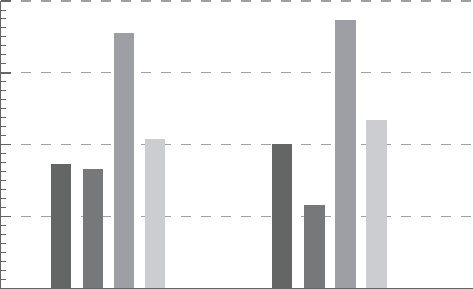
Sunden CH011.tex 10/9/2010 15: 22 Page 439
Evaluation of continuous and discrete phase models 439
DF
DF
Exp
Total deposition fraction (%)
CS
400 nm
1 µm
DF-VC
DF-VC
Exp
CS
10
0
10
−1
10
−2
10
−3
10
−4
Figure 11.5. Comparison of total deposition fraction as a percentage between
experimental results and model predictions for 400nm and 1µm
particles.
Experimental results of local 400nm particle depositions on a 1 × 0.69mm
grid are shown in Figure 11.6a as a percentage of total deposited particles [25].As
expected, localizedincreasesinparticledepositionareobservedatthebifurcations.
Deposition contours are in the range of 1 to 5% at the first carinal ridge and 0.1 to
1% at the second.Adiscontinuous shading pattern is observed inthefirst daughter
branches with contours in the range of 0.01 to 1%. At the second bifurcation,
higher contour values appear to extend down the inner branch in comparison with
the outer branch. Some asymmetry in the deposition pattern may be due to minor
variationsinthe inletparticleconcentration andalignment ofthegrid fieldwiththe
experimental model.
Numerical results of local particle deposition for 400nm aerosols are reported
on atwo-dimensionalgrid with elementsizes equivalent to theexperimental study,
i.e.,1×0.69mm(Figure11.6b–d).FortheCSmodeland400nmparticles,hotspots
of local particle deposition are not observed at the carinal ridges (Figure 11.6b).
As a result, the CS model appears to match the experimental totaldepositionvalue
but displays significant differences from local experimental findings. Moreover,
the CS model appears to predict more evenly distributed contours of deposition
throughout the physiologically realistic bifurcation (PRB) in comparison with the
experimental results. Considering the standard DF model, a significant increase in
local particle deposition is observed at the first carinal ridge and a lesser hot spot
occurs at the second bifurcation point (Figure 11.6c). However, these hot spots
are at a higher contour level than observed in the experiment and surrounded by
few deposited particles. The DF-VC model provides the best match to localized
experimental results for the deposition of 400nm par ticles (Figure 11.6d). Max-
imum localized particle deposition values at both carinal ridges are predicted to
be within the same range as observed experimentally. Specially, the DF-VC model

Sunden CH011.tex 10/9/2010 15: 22 Page 440
440 Computational Fluid Dynamics and Heat Transfer
(a) Experiment (b) CS model and 400 nm particles
(d) DF-VC model and 400 nm particles
Percent of deposited
400 nm particles
0.01 0.1 1 5
(c) DF model and 400 nm particles
Figure 11.6. Comparison between experimental and numerically determined con-
tours of local deposition for 400nm particles expressed as a per-
centage of total deposition: (a) experimental, (b) CS, (c) DF, and
(d) DF-VC models.
predictslocalized depositionat thefirst andsecond carinalridgestobe1to5%and
0.1 to 1%, respectively.Furthermore, the DF-VC model predicts elevated contours
within the range of 0.1 to 1% extending down the inner branch of G5, as observed
experimentally. Similar agreements between model and experimental results were
also observed for 1µm particles [25].
A significant finding from this direct comparison was that the CS and standard
DF models did not effectively predict the deposition of fine respiratory aerosols.
TheCSmodelhasbeenwidelyappliedinrespiratorydynamicssystemsforparticles
up to approximately 100nm [20,21,52,53]. However, only a few available studies
have applied a DF model for the simulation of respiratory aerosols [34,54]. No
previous study has implemented a DF model to determine the inertial deposition
of fine respiratory aerosols. Based on the available two-phase flow literature, the
standardDFmodelshouldadequatelymodelthedepositionofdilutefinerespiratory
Sunden CH011.tex 10/9/2010 15: 22 Page 441
Evaluation of continuous and discrete phase models 441
aerosols based on diffusional and inertial transport mechanisms [32,33]. However,
results of this study indicated a significant overprediction of respiratory aerosol
depositionwithuse ofthestandardDFformulation.Thisoverestimationwasdueto
significant changes in particle slip velocity between the near-wall control volume
center location and conditions at particle-to-wall contact.
11.6 Evaluation of the DF-VC Model in RealisticAirways
In this section, the DF-VC model was extended to transient conditions and was
tested in more complex geometries of the respiratory tract for laminar and tur-
bulent flows. Particle transport and deposition were evaluated in a computational
replicaof theTB geometry andan MRI-basednasalmodel.Numerical resultswere
compared to existing experimental datainthese models.A standard CSmodelwas
alsoconsideredtoevaluatetheextenttowhichtheDF-VCmodelcapturestheeffects
ofparticle inertia.Todetermine theinfluenceoftimeeffectson particledeposition,
steadyandtransientflowfieldswereevaluated.Thesestudiesareintendedtofurther
develop a highly effectivemethod for the simulation of fine respiratory aerosols in
realistic models of the upper airway.
11.6.1 Tracheobronchial region
Ahollowcast ofthehumanTBtree(Figure11.7a)utilizedbyCohenet al. [55]was
digitally replicated in this study to ensure a direct comparison with experimental
deposition results. The geometric parameters of the cast were in agreement with
population means of a representative average adult male.The original cast used in
thestudyofCohenetal.[55]wasscannedbyamultirow-detectorhelicalCTscanner
(GE medical systems, Discovery LS) with the following acquisition parameters:
0.7mm effective slice spacing, 0.65mm overlap, 1.2mm pitch, and 512 × 512
pixel resolution. The multislice CT images were then imported into MIMICS
(Materialise, Ann Arbor, MI) to convert the raw image data into a set of cross-
sectionalcontoursthatdefinethesolidgeometry.Basedonthesecontours,asurface
geometry wasmanually constructed in Gambit 2.3 (Ansys, Inc.) (Figure 11.7b and
c). Some distal branches in the range of generations G5 and G6 were not retained
inthe digitalmodel duetolowresolution. Mostofthe digitalmodel pathsextended
from the trachea to generation G4 with some paths extending to generations G5
and G6. Twenty-three outlets and a total of 44 bronchi were retained in the final
computationalmodel(Figure11.7b).Thesurfacegeometrywasthen imported into
ANSYS ICEM 10 (Ansys, Inc.) as an IGES file for meshing. To avoid excessive
grid elements, some minor smoothing of the geometric surface was necessary.
Theleft–rightasymmetry, whichisanimportantfeature ofthehumanlung,was
preserved in theTB model.There are three lobes in the right lung and two lobes in
the left.As observed in theTB model, the left main bronchus is approximately 2.5
times longerthan theright (Figure11.7b), whichis consistent withvanErtbruggen
et al. [56]. For conducting airways, the bifurcating pattern is typically asymmetric
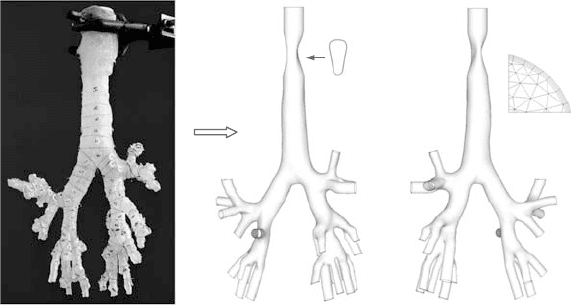
Sunden CH011.tex 10/9/2010 15: 22 Page 442
442 Computational Fluid Dynamics and Heat Transfer
(a) TB cast (b) Reconstructed surface
CT scans
MIMICS
ICEM
Left Left
Right Right
Glottis
Back view Front view
Near-wall mesh
Figure 11.7. Development of a tracheobronchial airway model from a replica cast
of the human upper respiratory tract: (a) the hollow cast utilized by
Cohen et al. [14] showing the divisions of sub-branch segments. A
mechanicallarynxwasconnectedtothecastinordertogeneratecyclic
inspiratory flows. (The figure was provided by Dr. Beverly Cohen,
NYU School of Medicine.) (b) A surface geometry was constructed
based on CT scans of the cast and software packages MIMICS and
Gambit. UsingANSYS ICEM 10, the computational mesh was gen-
eratedand consistedof unstructured tetrahedralcontrol volumeswith
a very fine near-wall grid of prism elements.
with daughter branches from the same parent often differing both in diameter and
length. Additionally, the spatial orientations of the bifurcating branches are quite
variable, resulting in a lung architecture that is highly out-of-plane.
A critical feature of the physiologically realistic TB model used in this study
is the inclusion of a laryngeal approximation and wedge-shaped glottis, as shown
in Figure 11.7b and c. Including a laryngeal approximation provides a better rep-
resentation of in vivo conditions and is significant in deposition studies with TB
casts [57]. Studies by Chan et al. [58], Gurman et al. [59], Martonen et al. [60],
and recently Xi et al. [35] have highlighted the significance of the laryngeal jet on
downstream deposition in the respiratory tract. The transient breathing conditions
of Cohen et al. [55] were approximated as a sinusoidal function with the for mat
Q(t) = Q
in
[
1 −cos
(
2ωt
)
]
; u(t) = u
mean
[
1 −cos
(
2ωt
)
]
(18a and b)
where ω is the breathing frequency in radians/s.
Compared with the idealized bifurcation model, interesting flow phenomena
are observed due to the complex geometry characteristics of the TB model such
as thepresence of thelarynx, left–right asymmetry, and non-coplanar bifurcations.
The laryngeal jet that forms attheglottis aperture extends downstream through the
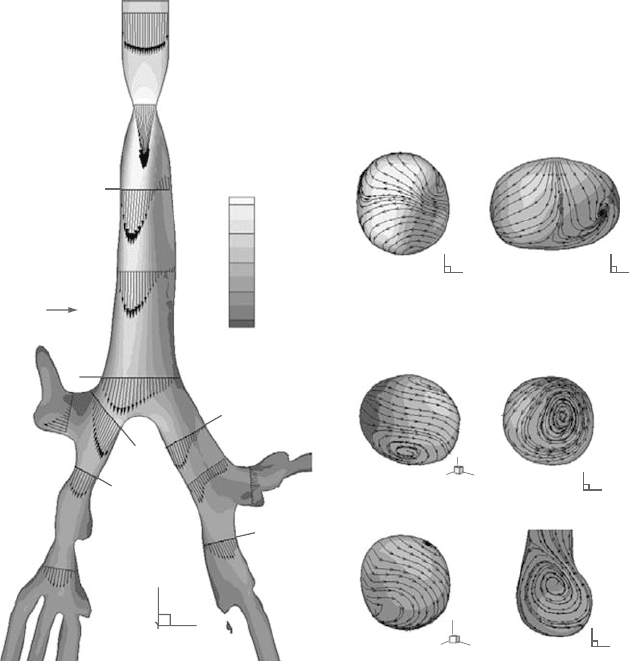
Sunden CH011.tex 10/9/2010 15: 22 Page 443
Evaluation of continuous and discrete phase models 443
x
z
y
x
z
x
y
z
x
y
z
x
y
z
x
y
z
R2
L2
L1
T2
200 cm/s
T1
360
275
190
105
20
Speed
(cm/s)
Q
in
= 34 L/min; steady state
Trachea
T2: SMIF = 0.10
R1: SMIF = 0.52
R2: SMIF = 0.40
L1: SMIF = 0.66
L2: SMIF = 0.43
T3: SMIF = 0.20
Right lung Left lung
R1
y
x
z
Figure 11.8. Midplane velocity vectors, contours of velocity magnitude, and in-
plane streamlinesof secondary motionin thetracheobronchial model
understeadyconditionswithaninspiratoryflowrateof34L/min.The
slices are not to scale.
trachea and is skewed toward the right wall (Figure 11.8). Flow reversal occurs
in the trachea due to the strong jetting effect. As a result, a large recirculation
zone develops near the left tracheal wall, which significantly reduces the cross-
sectional area available for expansion of the high-speed flow. Similar results have
beenreportedbyCorcoran andChigier[61]. Using LaserDopplerVelocimetry and
fluorescent dye, Corcoran and Chigier [61] also observed askewed laryngeal jet in
the right anterior trachea and a region of reverse flow in the left trachea with a cast
model. The skewed jet feature may have physiological implications that facilitate
efficientmixinganddeeperpenetrationofinhaledoxygenintothelung.Conversely,
higher particle deposition rates are expected on the right tracheal wall and in the
right downstream branches due to impaction.

Sunden CH011.tex 10/9/2010 15: 22 Page 444
444 Computational Fluid Dynamics and Heat Transfer
0
0.2
0.4
0.6
0.8
40 nm 200 nm
Exp
CS
steady
CS
tidal
DF-VC
tidal
DF-VC
tidal
Washout
phase
CS
tidal
Exp
DF-VC
steady
CS
steady
DF-VC
steady
Particle release
phase
Deposition fraction (%)
Figure 11.9. Comparison of total deposition fraction as a percentage between the
experimentalresults ofCohen etal. [14]and modelpredictions under
steady and transient conditions for 40 and 200nm particles.
For transient inlet conditions of a mean flow rate of 34L/min, the Womersley
number(α)rangesfrom4.2to0.8intheconductingairwaysofG0toG6,indicating
moderate to smallunsteady effects.As expected, transientflowpatterns are similar
to steady state conditions for a major portion of the breathing cycle (i.e., 0.15T
to 0.85T), resulting in what can be considered as a quasi-steady system [42]. In
contrast, during the transition phase between breathing cycles when the veloc-
ity is small, the fluid experiences dramatic changes in both mainstream flow and
secondary motion [35,42]. Similarly, Kabilan et al. [62] examined the flow char-
acteristics in a CT-based ovine lung model. Their results suggested that the onset
of the transient phase of the flow might be the main cause of vorticity formation,
whichplaysanimportantroleingasmixing.Lietal. [63]alsoreportedthatparticle
depositionhasastrong dependenceonindividualphasesofthetransientwaveform.
Comparisons of experimental and numerical values of total deposition in the
TB model geometry for 40 and 200nm particles are illustrated in Figure 11.9.
The experimental deposition values were reported by Cohen et al. [55] for cyclic
breathingwithameanflowrateof34L/minandabreathingfrequencyof20breaths
per minute. The transient numerical deposition fraction is a cumulative value that
includesboththeparticle-releasephase(2ndcycle)andthefollowingwashoutphase
(3rd and 4th cycles). The first cycle is airflow only, without particles, in order to
establishthetransient flowfield withintheTB geometry. Inthe caseof40nm parti-
cles,theexperimentaltotaldepositionrateis0.7%.BoththeCSandDF-VCmodels
closelymatchtheexperimentaldepositionvalueundersteadyconditionswithatotal
depositionpredictionof0.706and0.714%,respectively.Themarginallyhighertotal
deposition value of the DF-VC model indicates a negligible contribution of inertia
to total deposition for 40nm particles. In contrast, both models appear to underes-
timate the experimental result for transient conditions, resulting in a percent error
of−48.9% forthetransientCS modeland−21.1% forthetransientDF-VCmodel.
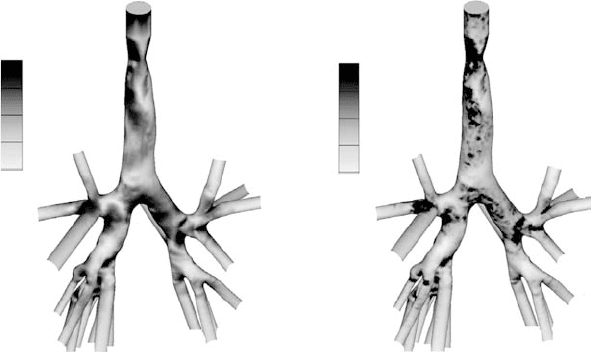
Sunden CH011.tex 10/9/2010 15: 22 Page 445
Evaluation of continuous and discrete phase models 445
1.8
0.9
0
2.7
3.6
DEF
Transient
ventilation
DEF
max
= 17.67
Transient
ventilation
DEF
max
= 266.77
(a) 40 nm (b) 200 nm
Right
Left
1.8
0.9
0
2.7
3.6
DEF
Right
Left
Figure 11.10. Numerically determined deposition enhancement factors (DEF) in
thetracheobronchialairwayundertransientconditionsatameanflow
rateof34L/minwiththeDF-VCmodelfor(a)40nmand(b)200nm
particles.
Experimentalcyclicdepositionresultsfor200nmparticlesindicateatotaldepo-
sition fraction of 0.38% (Figure 11.9). Due to a lack of particle inertia, the CS
modelsignificantlyunderpredictsthetotaldepositionfractionfor200nmaerosols,
resulting inpercent errors of−52.1% for steadyventilation and −81.3%for cyclic
ventilation. The DF-VC model provides a substantial improvement over the CS
approach by incorporating the particle inertia forces in the computational model.
Aswith 40nmparticles, predictions ofthe DF-VCmodelfor200nmparticles with
steady flow are in close agreement with the experimental results, with a minor
underestimation of −8.4%. For cyclic conditions, the DF-VC approach predicts a
totaldeposition of0.257%, resultingin adifference of−32.4% incomparisonwith
the experiment. Comparing these two models, differences between the CS predic-
tions and the experimental results are significant for 200nm particles, indicating
a significant contribution from particle inertia. Still, an under prediction of depo-
sition for 200nm particles is observed with the DF-VC model. As noted before,
some distal branches of the TB cast were not included in the numerical model and
a static open glottis was employed, which may contribute to this under prediction
of the experimental results for both steady and transient inhalation conditions.
Figure 11.10 illustrates the DEF value for the DF-VC model under cyclic con-
ditions with a mean flow rate of 34L/min. For the DF-VC model, the deposition
patterns under steady and cyclic conditions are similar in appearance for 40 and
200nmparticles, respectively. However,moreconcentrated localdepositionvalues
in the larynx and bifurcations are obtained under cyclic conditions compared with
steady state.Specifically, the maximumDEF value for 200nm aerosolswithcyclic
flow (i.e., 267)is about seventimeshigher thanwiththe steadycondition(i.e., 37),
